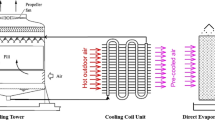Abstract
A novel indirect evaporative chiller driven by outdoor dry air to produce cold water as the cooling source for air conditioning systems is introduced, and the principle and the structure of the chiller is presented. The cold water can be produced almost reversibly under ideal working conditions, with its temperature infinitely close to the dew point temperature of the inlet air. The key components of the chiller are an air cooler and a padding tower. To improve the heat transfer performance inside the chiller, a quasi-countercurrent air cooler was designed; a subsection linear method was used for the mathematical model of the padding tower. The first indirect evaporative chiller, designed and developed in 2005, has been in use in Kairui Building, a big hotel in Shihezi, Xinjiang Autonomous Region. The tested temperature of the water produced is below the wet bulb temperature of outdoor air and reached the average value of the dew point temperature and the wet bulb temperature of outdoor air. As the running components are only pumps and fans, the COP (cooling energy for room divided by power cost) of this chiller is high, and the drier the outdoor air, the higher COP the chiller obtained. Since no CFCs are used in this chiller, it would not cause any pollution to the aerosphere. Finally, the application prospect of the indirect evaporative chiller in the world is presented.
Similar content being viewed by others
References
Watt John R. Evaporative Air Conditioning. New York: The Industrial Press, 1963
Scofield C M, Deschamps N H. Indirect evaporative cooling using plate type heat exchangers. ASHRAE Transactions, 1984, 90(1B): 148–153
Wu H, Yellott J I. Investigation of a plate-type indirect evaporative cooling system for residences in hot and arid climates. ASHRAE Transactions, 1987, 93(1): 1252–1260
Watt J R. Nationwide evaporative cooling is here. ASHRAE Transactions, 1987, 93(1): 1237–1251
Tulsidasani T R, Sawhney R L, Singh S P, Sodha M S. Recent research on an indirect evaporative cooler (IEC) Part I: optimization of the COP. International Journal of Energy Research, 1997, 21(12): 1099–1108
Scofield C M. The heat pipe used for dry evaporative cooling. ASHRAE Transactions, 1986, 92(1B): 371–381
Qiu G Q, Riffat S B. Novel design and modelling of an evaporative cooling system for buildings. International Journal of Energy Research, 2006, 30(12): 985–999
Kharrufa S N, Adil Y. Roof pond cooling of buildings in hot arid climates. Building and Environment, 2008, 43(1): 82–89
Al-Saud K A M, Al-Hemiddi N A M. The effectiveness of natural evaporative cooling in improving internal thermal environment in hot-dry regions. International Journal of Ambient Energy, 2003; 24(2):83–92
Gasparella A, Longo G A. Indirect evaporative cooling and economy cycle in summer air conditioning. International Journal of Energy Research, 2003, 27(7): 625–637
Costelloe B, Finn D. Indirect evaporative cooling potential in airwater systems in temperate climates. Energy and Buildings, 2003, 35(6): 573–591
Jiang Yi, Li Zhen, Xue Zhifeng. An indirect evaporative cold water produced installation. China Patent 02202739.4, 2002
Ren Zepei, Cai Ruixian. Thermo Engineering Handbook. Beijing: China Machine Press, 2002
National Meteorological Information Center, Department of Building Science and Technology, Tsinghua University. China Special Meteorological Data for Building Thermal Environment Analysis. Beijing: China Architecture & Building Press, 2005
Author information
Authors and Affiliations
Corresponding author
Rights and permissions
About this article
Cite this article
Xie, X., Jiang, Y. An indirect evaporative chiller. Front. Energy Power Eng. China 4, 66–76 (2010). https://doi.org/10.1007/s11708-010-0021-1
Received:
Accepted:
Published:
Issue Date:
DOI: https://doi.org/10.1007/s11708-010-0021-1




